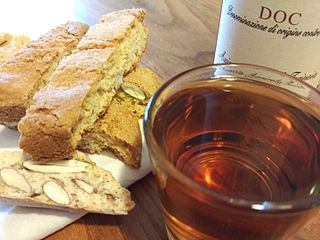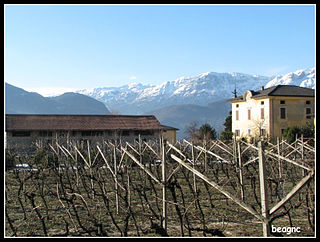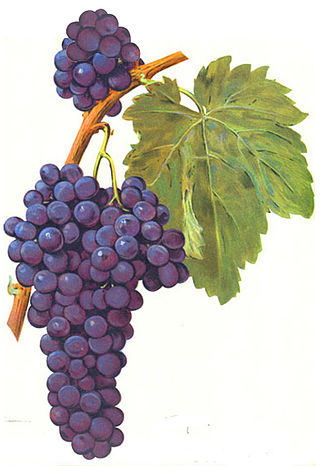
Trollinger, Schiava, or Vernatsch, is a red German/Italian wine grape variety that was likely first originally cultivated in the wine regions of South Tyrol and Trentino, but today is almost exclusively cultivated on steep, sunny locations in the Württemberg wine region of Baden-Württemberg. It is primarily known under the synonyms Trollinger in Germany, Vernatsch in South Tyrol and Schiava in other Italian regions. As a table grape the variety is sometimes known as Black Hamburg, which is commonly confused with the similar synonym for Black Muscat—a variety that is actually a cross of Trollinger and Muscat of Alexandria.

Vin Santo[vin ˈsanto] is a style of Italian dessert wine. Traditional in Tuscany, these wines are often made from white grape varieties such as Trebbiano and Malvasia, though Sangiovese may be used to produce a rosé style known as "Occhio di Pernice" or eye of the partridge. The wines may also be described as straw wines since they are often produced by drying the freshly harvested grapes on straw mats in a warm and well ventilated area of the house. Though technically a dessert wine, a Vin Santo can vary in sweetness levels from bone dry to extremely sweet. While the style is believed to have originated in Tuscany, examples of Vin Santo can be found throughout Italy and it is an authorised style of wine for several Denominazione di origine controllata (DOCs) and Indicazione geografica tipica (IGTs).
Breganze is a town in the province of Vicenza, Veneto, Italy. It is northeast of Via Romea. During World War II, the Germans were on one side of the river and the Allies were on the other, and a firefight occurred across the river.
Greco is an Italian wine grape that may be of Greek origin. The name relates to both white (Greco bianco) and black (Greco nero) grape varieties. While there is more land area dedicated to Greco nero, the Greco bianco is the grape most commonly referred to by "Greco". In the Campania region it is used to produce the Denominazione di Origine Controllata e Garantita (DOCG) wine Greco di Tufo. In Calabria, it is used to make the Denominazione di Origine Controllata (DOC) wine Greco di Bianco. The name "Greco" is sometimes used as a synonym for several varieties of supposed Greek origins-most notably Trebbiano.

Friuli-Venezia Giulia wine is wine made in the northeastern Italian region of Friuli-Venezia Giulia. There are 11 Denominazione di origine controllata (DOC) and 3 Denominazione di Origine Controllata e Garantita (DOCG) in the Friuli-Venezia Giulia area. The region has 3 Indicazione Geografica Tipica (IGT) designations Alto Livenza, delle Venezie and Venezia Giulia. Nearly 62% of the wine produced in the region falls under a DOC designation. The area is known predominantly for its white wines which are considered some of the best examples of Italian wine in that style. Along with the Veneto and Trentino-Alto Adige/Südtirol, the Friuli-Venezia Giulia forms the Tre Venezie wine region which ranks with Tuscany and Piedmont as Italy's world class wine regions.
Verduzzo is a white Italian wine grape grown predominantly in the Friuli-Venezia Giulia region of northeast Italy. It is also found in significant plantings in the Piave Denominazione di origine controllata (DOC) of the Veneto region, though some of these plantings may be of the separate Verduzzo Trevigiano variety. Verduzzo Friulano is used in varietal and blended wines, many of which fall under DOC as well as vino da tavola designations, that range in style from dry to late harvest wines. According to wine expert Oz Clarke, most of the sweeter examples of Verduzzo can be found in the Friuli-Venezia Giulia with the grape being used for progressively drier styles of the wine the further west into the Veneto.
Verdeca is a white Italian wine grape variety that is primarily grown in Apulia in southern Italy where ampelographers believe that the grape may have originated. In Apulia, it is one of the main grapes in the Denominazione di origine controllata wines of Locorotondo DOC and Martina Franca DOC along with Bianco d'Alessano. In Campania, it is grown on the slopes of Mount Vesuvius where it used as a blending variety with Falanghina, Coda di volpe and Greco in both the white wines and the sweet dessert wine of the region, Lacryma Christi. It is also a minor component used in the some vermouth production.

Bombino bianco is a white Italian wine grape variety planted primarily along Italy's Adriatic coast line, most notably in Apulia. The vine is prone to high yields and often produces neutral flavor wines. The grape is known under many synonyms throughout Italy including Debit and Pagadebit, names which came from the grape's reputation for being a high yielding and reliable crop for vineyard owners to grow that would assure them that on each vintage they could pay off their debts.

Trento DOC is an appellation for white and rosé sparkling wine made in Trentino, Italy. Trentinos developed this appellation, the second in the world after Champagne, to ensure quality and distinction. Only Chardonnay, Pinot noir, and Pinot Meunier with Pinot blanc are permitted, and they must be grown in a well-defined area within the Province of Trento.
Bombino nero is a red Italian wine grape variety that is grown in southern Italy, particularly the regions of Apulia, Basilicata, and Lazio, as well as on the island of Sardinia. It is a permitted grape variety in the Denominazione di origine controllata (DOC) wines of Castel del Monte and Lizzano. The grape is primarily a blending grape but it can also be used as a varietal for red and rosé wines. Though DNA evidence has shown that Bombino nero is not a dark-berried color mutation of the similarly named Bombino bianco, ampelographers still believe that the two varieties are related in some way.

Incrocio Manzoni or Manzoni grapes is a family of grape varieties named after Professor Luigi Manzoni (1888-1968) of Italy's oldest school of oenology located in Conegliano, in the Veneto region. Manzoni created the new grape varieties by selecting, crossing and grafting vines from various vineyards during the 1920s and 1930s. The family includes both white and red grape varieties. Although most Manzonis are grown in northeastern Italy, they are mainly grown in the Piave area of Province of Treviso and are only now starting to be sold commercially in Europe and the United States.

Petit Rouge is a red Italian wine grape variety that ampelographers believe is indigenous to the Valle d'Aosta region of northwest Italy. However, there is some confusion about whether Petit Rouge is the same variety as the red Swiss wine grape Rouge de Valais.

Trentino is the southern part of the Trentino-Alto Adige/Südtirol autonomous region of Italy. Wine is produced in Trentino from several grape varieties, including the native Nosiola, Teroldego, and Marzemino varieties. There are six wine DOCs in Trentino.

Pecorino is a white Italian wine grape variety that grows in the Marche, Abruzzo, Tuscany, Umbria and Lazio regions of Italy. Ampelographers believe that the grape is likely native to Marche, where the soil destined for this cultivation increases every year. This grape variety is used to produce the DOCG wines, like the Offida Pecorino DOCG, and the DOC wines, like the Falerio dei Colli Ascolani, the Colli Maceratesi and the Falerio dei Colli Ascolani.
Marzemina bianca is a white Italian wine grape variety that is grown in the Veneto region of northeastern Italy. Ampelographers believe that the grape is a natural crossing of the Trentino wine grape Marzemino and the Soave wine grape Garganega. This parent-offspring relationship between Marzemina bianca and Marzemino makes the variety distinct from grapes like Pinot blanc and Grenache blanc which are other color mutations of Pinot noir and Grenache, respectively. DNA analysis has confirmed that the Veneto grape Raboso Veronese is the offspring of Marzemina bianca and Raboso Piave.
Lagarino bianco is a white Italian wine grape variety that is grown in the Trentino-Alto Adige/Südtirol wine region of northeast Italy. It was once thought that the grape was a white berry color mutation or offspring of South Tyrolean grape Lagrein with a weiss Lagrien grape variety reportedly growing near the commune of Bolzano in 1318 but DNA profiling conducted in the early 21st century has shown that the two grape varieties are distinct with no direct relationship to each other.
Minella bianca is a white Italian wine grape variety that is indigenous to the island of Sicily where it is grown in the foothills of Mount Etna. The name Minella is derived from the Sicilian word minna to which the berries have some resemblance due to their elongated shape. Minella bianca is very rarely seen as a varietal and is most often used in field blends with Carricante and Catarratto bianco.
Pallagrello bianco is a white Italian wine grape variety that is grown in Campania. The grape has a long history in the region and was one of the varieties planted in 1775 by architect and engineer Luigi Vanvitelli in the fan-shaped Vigna del Ventaglio vineyard created for the royal palace of King Ferdinand I of the Two Sicilies in Caserta. Following the phylloxera epidemic of the mid-19th century and the economic devastation of the World Wars of the early 20th century, plantings of Pallagrello bianco declined greatly and the variety was thought to be extinct until it was rediscovered growing in an abandoned Campanian vineyard in the 1990s.
Piccola nera is a red Italian and Slovenian wine grape variety that is grown in the province of Trieste within the Friuli-Venezia Giulia wine region and across the border in neighboring Slovenia where ampelographers believe that the grape originated. Piccola nera, whose name means "little black", tends to produce to light bodied red and rosé wines that are meant to be consumed young. It is a permitted variety in the Denominazione di origine controllata (DOC) wines of Carso where it is usually blended with Terrano and in Venezia Indicazione geografica tipica IGT classification where the grape can be used to make varietal wines.
Bianchetta Trevigiana is a white Italian wine grape variety that is grown in the Trentino-Alto Adige/Südtirol and Veneto wine regions of northeast Italy. Here the grape is rarely used a varietal but, instead, is a permitted blending grape adding acidity to the wines of several Denominazione di Origine Controllata (DOC) zones including the sparkling wine Prosecco and has also been used for vermouth production. The name Trevigiana is derived from the province of Treviso where the grape is believed to have originated from.












